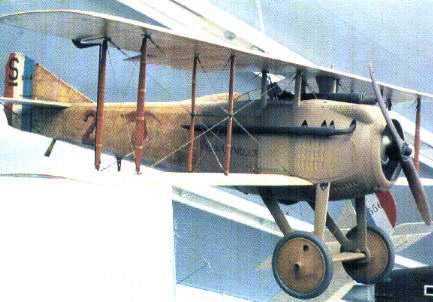![]() CHARLES FAIR
CHARLES FAIR
![]()
Just outside the Peripherique - the infamous Paris ring-road - are some places that you may consider visiting if you are researching a particular aspect of the Great War.

Le Musee de l'Air et de l'Espace is north of Paris at Le Bourget airport. This covers the history of flight from the Montgolfier brothers to the space age. The section devoted to the Great War is worth a visit. However, my knowledge of the war in the air is negligible, so I have no idea how the selection of aircraft displayed compares with that in other museums, and whether it is enough for the serious enthusiast. I visited on one of the days of the biennial Paris Airshow, and the 'old stringbags' made a wonderful contrast to the state-of-the-art wizardry parked on the tarmac outside.
The aircraft displayed are: Fokker D-VII, Pfalz D-XII, Junkers J9 (D1), De Havilland DH9, Breguet 14A2, Nieuport XI 'Bebe', Spad XIII and a Spad VII. This latter aeroplane is likely to be of greatest interest since it is the Spad VII that was flown by Captain Georges Guynemer when he served with the squadron 'Les Cigognes' (the storks). The squadron insignia, a red stork, and the name he gave to his aircraft, 'Vieux Charles', are painted on the fuselage.

Guynemer's SPAD
The museum also contains the cabin of Zeppelin LZ113. This particular military Zeppelin was given to France as part of the reparations for the Great War. The cabin is equipped with two Maxim guns. The gallery also displays a vehicle and winch equipment that was used to raise and lower observation balloons.
Just outside the peripherique are several massive city cemeteries that were started in the late 19th century since those within the city boundaries, such as Pere-Lachaise, were nearly full. One of these is Pantin Cemetery which is on the north-eastern side of the city, near the Porte de la Villette, and just off the N2 road to Le Bourget. At the western end of the cemetery, and near the main entrance, are about one thousand French military graves in four plots, and 68 German graves. Amongst the French graves is the second largest CWGC plot in the Paris region after that in the Versailles St. Gonards cemetery. It records 71 UK, 11 Australian and 11 Canadian burials of men who died in hospitals in the city, mainly in the autumn of 1914 and the summer of 1918, as well as a few who died after the Armistice. A photograph of the plot can be found in 'The Silent Cities' (p. 339).
East of Paris, the medieval Chateau of Vincennes is notable since the spy Mata Hari was executed by firing squad within its walls in 1917. It also houses the archives of the French armed services, the Service Historique des Armees, which consists of an archive and library for each of the three services.
At the time of writing I have so far spent one day having a look at the collections of the Service Historique des Armees de Terre (SHAT). In general I found the staff to be very helpful, though I have no doubt that it helps to have a reasonable command of the language. It is open during the week during normal working hours, and is closed on bank holidays and for all of August. Although one doesn't need to book, I recommend telephoning first in order to check opening hours and that there will be no strikes that day. (Telephone +33 (01) 41 93 38 00 and ask to be put through to SHAT.)
The SHAT library is in one building. The large collection seems to have a fairly thorough card index by subject (as well as title/author) and I had no difficulty in finding what I wanted. I was particularly pleased to find a - presumably - complete listing of the French language Michelin guides. I also had a glance at some of the massive 'Armee Francaise dans la Grande Guerre' - a work consisting of over 100 volumes of which 24 are the history, and the rest maps and appendices.
The SHAT archives themselves are in another building of the chateau. I was mainly interested in the trench map collection which turned out to be very impressive. I haven't completely worked out how the large and detailed index works. It seems to be based on the 1:20,00 series (which seem to correspond in area to the IGN 1:25,000 series), each of which is split into four 1:10,000 maps i.e. NW, NE, SW, SE. In addition, 1:5,000 maps were made for certain areas, in the same way as the BEF did, for example 'la Fille Morte' and 'la Four de Paris' sectors of the Argonne forest. It seems as if one needs to know which 1:20,000 map one's target area is in before one can get the larger scales.
With the assistance of a member of staff to hold the maps out to prevent damage, I was able to make photocopies there myself. With eight A3 pages at 3 FF each to a 1:20,000 or 1:10,000 sheet this works out at only 24 FF per map. Unfortunately, SHAT really doesn't seem to be aware of the damage that undersized photocopiers can do to the oversized map sheets (because of folding etc). There are no A1, A2 size photocopiers like those used by the British Public Records Office. Personally I'd prefer to pay more to get a map on a single sheet, as one would from the PRO or the WFA's own trench map service, rather than muck around trying to stick A3 pages together.
Overall, I was left with the impression that the range of customer services available from SHAT is not as comprehensive as those of the PRO. However, it is a much smaller organisation. I don't know whether it can handle requests by post. If one is really searching for something specific, I doubt that there is an alternative to going in oneself, provided that the language is not a problem.
As a result of a recent visit to the Ministère des Anciens Combattants and Victimes de Guerre in Paris, I gained a copy of its brochure '1914-18 l'Armée Coloniale - les soldats d'outre-mer: monuments et sépultures'. This told me about a Great War site on the edge of the Bois de Vincennes that was previously unknown to me. I duly followed this up one grey December day, and it turned out to be one of the most fascinating memorial sites that I have yet visited in France.
The site is the Jardin Colonial of Nogent-sur-Marne. The garden was created at the turn of the century, and grew over the years, eventually becoming the Centre Forestier Tropical in the 1950s, and today it is within the grounds of l'Institut de Recherches Agronomique Tropicale. This is marked on the Michelin map 101 'Banlieue de Paris - Du Peripherique a la Francilienne' and can be found at the eastern end of the Bois de Vincennes at 45 bis, Avenue de la Belle-Gabrielle. The garden itself is at the northern end of the complex and a Chinese gateway is clearly visible from the road.
After the Great War the ancien combattants from the Far East founded the Souvenir Indochinois which has the aim of maintaining the graves and memorials to Indochinese troops, both in France and on the other fronts. (A total of 48,922 Indochinese troops served France during the Great War.) The association chose the Colonial Garden as a place of commemoration since it already contained a Cochinchinese house. The French State made a gift of the building to the association who turned it into a Buddhist temple. The building was originally erected at Marseilles for the Colonial Exhibition of 1906 as an example of Vietnamese architectural art, and was then dismantled and rebuilt in the garden. During the Great War the building and the others nearby served as a temporary military hospital.
In 1922 the emperor of Annam, Khai Dinh, went to honour the temple and the spirits of the dead soldiers. The edifice sheltered the 'imperial rescript' of 1920 (which I presume was some kind of document or decree) and two altars. In 1984 the main building of the temple was totally destroyed by a fire since it had been constructed entirely out of wood. It was replaced by a pagoda-monument which was inaugurated in 1992. The bright red pagoda set against the background of a stand of bamboo is one of the most bizzarely out-of-place buildings one could hope to find in an otherwise ordinary Paris suburb. The gateways and walls that surrounded the original temple still stand, though they are in rather poor state of repair.
During the 1920s five other monuments to commemorate colonial troops of all colours, races and creeds were built in the grounds. I was pleased to see a new Armistice Day wreath at the foot of each one. Beside the temple is the simple Monument aux Indochinois Chrétiens, (Indochinese Christians). On one side of the main lawn is the Monument aux Soldats Coloniaux, an unadorned obelisk which lists all the French colonial territories by region of the globe. On the other side of the lawn is the Monument aux Soldats Noirs which consists of a large bas-relief of an African woman who is standing beside a battlefield grave. The Monument aux Malgaches, a square column surmounted by a bronze of a large bird of prey, commemorates the Madagascan troops, of which 41,355 fought for France. The most unusual memorial is the Monument aux Laotiens and Cambodgiens. This is in the shape of a 'phnom', a conical stone structure that recalls Cambodian temples such as Angkor Wat.
(The best time to visit the garden is during working hours during the week when you should be able to gain access via the front gate. Armistice Day is probably the best day of all. The garden is closed at weekends.)
When I had completed my tour of the garden I went on into the town to find Nogent-sur-Marne communal cemetery. Many of the men who died of wounds or disease in the hospital of the Colonial Garden were buried here. In the centre of the plot is an obelisk, the Monument aux Indochinois, one face of which lists their names. This is surrounded by a large group of graves of North African soldiers, and a smaller number of graves of Senegalese, Somalian and French soldiers. I noticed one grave of a man from the Bataillon de Tirailleurs du Pacifique. This battalion was raised at Noumea on 4 June 1916 and saw action on the Aisne in July and August 1918. A total of 1,067 Polynesians and Kanaks served under the tricolore in the Great War.
(The cemetery is about half-a-mile north of the town centre at the far end of the Boulevard de Strasbourg (N34), and just east of the railway, so that it is almost in the neighbouring town of Le Perreux.)
![]()
 Copyright © Charles Fair, June,
1997.
Copyright © Charles Fair, June,
1997.
Return to the Charles Fair Battlefield Guide START page
Return to the Hellfire Corner Contents Section
|